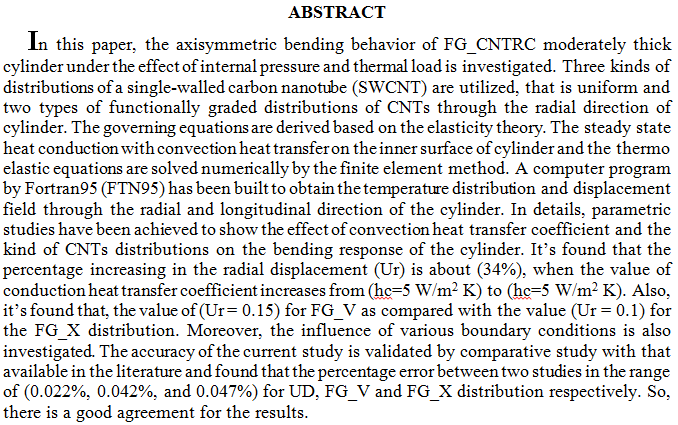
APDBN Rashid, International Journal of Humanities and Social Sciences/ RIMAK, 2023
The researchers of the present study have conducted a genre analysis of two political debates between American presidential nominees in the 2016 and 2020 elections. The current study seeks to analyze the cognitive construction of political debates to evaluate the typical moves and strategies politicians use to express their communicative intentions and to reveal the language manifestations of those moves and strategies. To achieve the study’s aims, the researchers adopt Bhatia’s (1993) framework of cognitive construction supported by van Emeren’s (2010) pragma-dialectic framework. The study demonstrates that both presidents adhere to this genre structuring to further their political agendas. For a positive and promising image
... Show MoreThe preparation, spectroscopic characterisation of complexes derived from the mixed ligands with CdII, ZnII and CoII metal ions with Schiff base, Dithiocarbamates (DTCs) and 8-Hydroxyquinoline are reported. The compounds that prepared have been defined via; chloride content, F.T-IR, UV-Vis 1H-NMR spectroscopy and C.H.N.S, as well as conductance and magnetic susceptibility.All data which collected from such methods specified complexes with 6 coordinates in solution and solid states. The biologicalactivity that is related to all the prepared compounds which were screened for their antimicrobial activitiesagainst (G+ and (G-)). The data that collected from biological activity indicate that complexes will have extra activity against such tested
... Show MoreNanocrystalline micro-mesoporous ZSM/MCM-41 composite was synthesized using alkaline treatment method and two step of crystallization in poly tetraflouroethylene (PTFE) lined autoclave. The synthesized zeolites was characterized by X-Ray diffraction (XRD), Scanning electron microscopy (SEM), Transmission electron microscopy (TEM), Atomic force microscopy (AFM), Fourier transport infrared (FTIR), and N2 adsorption-desorption (BET). It was approved that the best results for alkaline leaching can be got with 1.5M NaOH solution. High surface (BET) area of 630 m2/g with pore volume of 0.55 cm3/g has been got. AFM reports showed a nano-level size for average particle size of 50nm.
The study of Stress- Strain relation for novolac reinforced by qujurate plant was carried out before and after the immersing in boiled water at 100C0 . It was found that the compression strength and surface hardness decreased when the composites immersed in boiled water for long times.
 (3)
(3)
 (3)
(3)
Aluminum Metal Matrix Composites (ALMMCs) was prepared by using stir casting technique for AA 7075 aluminum alloy as a matrix reinforced with SiC particles at various percentages (3, 6, 9 and 12 wt. % ) and 75µm in grain size. The prepared composite material can be used for many applications such as aerospace, automobiles and many industrial sectors. Abrasive wear test was carried out by two stages: the first stage was done by changing the emery papers at various grit sizes 180, 320, 500, and 1000µm with constant applied load 15N. While the second stage was carried out by changing the applied loads 5, 10, 15, 20 and 25N with constant emery paper at 320 µm grit size. Microstructure examination, hardness test and roughn
... Show MoreBendable concrete, also known as Engineered Cementitious Composite (ECC) is a type of ultra-ductile cementitious composites reinforced with fibres to control the width of cracks. It has the ability to enhance concrete flexibility by withstanding strains of 3% and higher. The properties of bendable concrete mixes (compressive strength, flexural strength, and drying shrinkage) are here assessed after the incorporation of supplementary cementitious materials, silica fume, polymer fibres, and the use of ordinary Portland cement (O.P.C) and Portland limestone cement (IL). Mixes with Portland limestone cement show lower drying shrinkage and lower compressive and flexural strength than mixes with ordinary Portland cement, due to the ratio o
... Show MoreConventional concretes are nearly unbendable, and just 0.1 percent of strain potential makes them incredibly brittle and stiff. This absence of bendability is a significant cause of strain failure and has been a guiding force in the production of an elegant substance, bendable concrete, also known as engineered cement composites, abbreviated as ECC. This type of concrete is capable of displaying dramatically increased flexibility. ECC is reinforced with micromechanical polymer fibers. ECC usually uses a 2 percent volume of small, disconnected fibers. Thus, bendable concrete deforms but without breaking any further than conventional concrete. This research aims to involve this type of concrete, bendable concrete, that will give solut
... Show MoreConventional concretes are almost unbending, and even a small amount of strain potential leaves them brittle. This lack of bendability is a major source of strain loss, and it has been the main goal behind the development of bendable concrete, often known with engineered ce ment composites, or ECC. This form of concrete has a lot more flexibility than regular concrete. Micromechanical polymer fibers are used to strengthen ECC. In most cases, ECC uses a 2% amount of thin, separated fibers. As a result, bendable concrete deforms but unlike traditional concrete, it does not crack. This study aims to include this kind of concrete, bendable concrete, which can be used to solve concrete problems. Karasta (CK) and Tasluja (CT) Portland Lime
... Show More